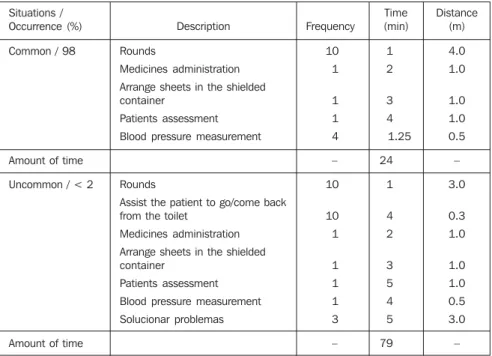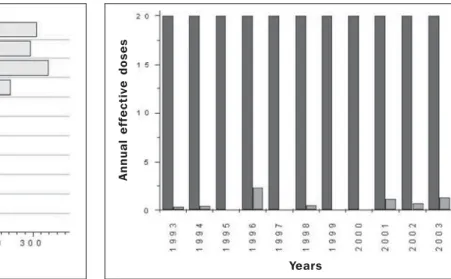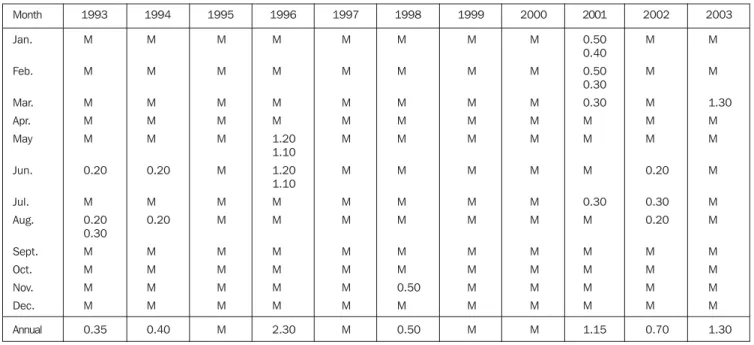263 Occupational exposure of nursing staff working with radioiodine therapy
Radiol Bras 2007;40(4):263–266 Original Article
OCCUPATIONAL EXPOSURE OF NURSING STAFF WORKING
WITH RADIOIODINE THERAPY DURING 11 YEARS*
José Ulisses Manzzini Calegaro1, Sandra Mara Pessano Teixeira2
OBJECTIVE: The present study was aimed at evaluating the occupational exposure of nursing staff in charge of inpatients undergoing 131
I therapy during 11 years. MATERIALS AND METHODS: The exposure situa-tions were classified according to a questionnaire answered by three nursing attendants, correlating the pro-cedures with activities, distances and amount of time in the iodotherapy room. Records of received doses by two types of dosimeters were evaluated over two subsequent periods. In both periods the nursing atten-dants received instructions about radiological protection. RESULTS: In usual situations, their amount of time in the iodotherapy room was in compliance with the standard time established by the service. In unusual situations, where the patient needed assistance for mobility, the exposure period was above the standard. However, this exposure occurs casually (only one or two times a year). During the period between 1993 and 1999 (dosimetric films) there were ten dose records, all of them at record level. From 2000 to 2003 (ther-moluminescent dosimeters) ten dose records were also obtained, with only one of them at the investigation level. During this study period, the mean 131
I activity was doubled. CONCLUSION: Despite the increased levels of activity there was no significant increase in dose to nursing attendants.
Keywords: Occupational exposure; Effective dose; External individual monitoring; Iodo-therapy.
Avaliação da exposição ocupacional de auxiliares de enfermagem na iodoterapia durante 11 anos.
OBJETIVO: O objetivo deste estudo foi avaliar a exposição ocupacional de auxiliares de enfermagem encar-regados da assistência aos pacientes internados para terapia com 131
I, num período de 11 anos. MATERIAIS E MÉTODOS: As situações de exposição foram classificadas de acordo com as respostas de três atendentes a um questionário que relaciona os procedimentos realizados às atividades administradas, às distâncias e aos tempos de permanência na enfermaria. Os registros das doses recebidas em dois tipos de dosímetros, em dois períodos subseqüentes, foram analisados. Em ambos os períodos os atendentes receberam instru-ções de proteção radiológica. RESULTADOS: Nas situainstru-ções comuns o tempo de permanência na enfermaria está dentro do tempo de referência utilizado. Nas situações não-comuns, quando o paciente necessita de auxílio na locomoção, o tempo de exposição está acima do tempo de referência, no entanto, essa exposição ocorre somente uma ou duas vezes por ano. No período de 1993 a 1999 (filme dosimétrico) houve dez re-gistros de doses, sendo todas ao nível de registro. No período de 2000 a 2003 (dosímetro termoluminescen-te) houve dez registros de doses, sendo uma delas situada no nível de investigação. Nesse período a ativi-dade média utilizada duplicou. CONCLUSÃO: Não foi observado aumento significante nas doses dos aten-dentes.
Unitermos: Exposição ocupacional; Dose efetiva; Monitoração individual externa; Iodoterapia. Abstract
Resumo
* Study developed in the Centro de Medicina Nuclear do Hos-pital de Base do Distrito Federal, Secretaria de Estado de Saúde (State Secretariat of Health), Brasília, DF, Brazil.
1. MD, Head for the Centro de Medicina Nuclear do Hospital de Base do Distrito Federal, Secretaria de Estado de Saúde, Bra-sília, DF, Brazil.
2. Medical Physicist, Centro de Medicina Nuclear do Hospital de Base do Distrito Federal, Secretaria de Estado de Saúde, Brasília, DF, Brazil.
Mailing address: Dr. José U.M. Calegaro. AOS 6, bloco D, ap. 604. Brasília, DF, Brazil, 70660-064. E-mail: jcalegaro@uol. com.br
Received October 30, 2006. Accepted after revision February 5, 2007.
INTRODUCTION
In the last decade, total thyroidectomy has been adopted as an initial modality for management of differentiated thyroid can-cer, contemplating its variable multicen-tricity. The 131I ablation of the remaining
tissue allows the utilization of suppressive hormone therapy to avoid the proliferation of further residual nuclei of cancerous cells, as well as to follow-up the progress of the disease through the serum levels of thyreoglobulin(1). For these reasons, there has been a considerable increase in the uti-lization of 131I as complementary therapy. Some routine procedures are performed by nursing assistants who attend to one or two inpatients during the 131I therapy, and therefore they are exposed to radiation emissions from these patients. This expo-sure is variable according to the number of inpatients, procedures performed, the dis-tance kept from the patient, and amounts of time in the ambulatory.
The present study is aimed at evaluat-ing the exposure circumstances and effec-tive doses to nursing assistants involved in the administration of 131I therapy in the period between 1993 and 2003, with two types of individual monitoring devices: dosimetric films and thermoluminescent dosimeters(2,3).
MATERIALS AND METHODS
264
Calegaro JUM, Teixeira SM.
Radiol Bras 2007;40(4):263–266 radiation, a questionnaire on tasks
descrip-tion was elaborated to be answered by them (Chart 1). This questionnaire asked the re-spondents to describe their routine tasks — common situations —, and situations where patients presented some locomotion difficulty — uncommon situations. There were questions about frequency of events, distances kept, and mean amount o time in the therapy room for the each task perfor-mance, considering two inpatients, during two days. The situations description and estimates can be found on Table 1. The per-centages of common and uncommon situ-ations were estimated with basis on the service records.
The amount of time spent in tasks dur-ing patients’ stays was compared with the amounts of time in the therapeutic ambu-latory utilized as a reference in the ser-vice(4), considering the activities and per-centages of occurrence of these radiation doses. These comparative results can be found on Table 2.
The effective doses in two consecutive periods and in two types of individual monitoring devices were compared to the required maximum limits of annual doses(5) (Figure 2). For this purpose, a survey was conducted to determine the activities in-volving 131I therapy in the period between 1993 and 2003 (Figure 1), and the effective dose to the three nursing assistants in charge of the inpatients (Table 3). In the period between 1993 and 1999, the indi-vidual monitoring method utilized was the dosimetric film supplied by the Laboratory of Radiological Protection of Department of Nuclear Energy – Universidade Federal de Pernambuco. In the 2000–2003 period, thermoluminescent dosimeters (Sapra Landauer Ltda.) were utilized.
Dosimetric film consist of a radiographic film utilized to differentiate the several radiation energies, whose blackening is caused by the incidence of ionizing radia-tion through several filters, allowing the estimation of the radiation dose received by the user(3). The dosimetric films sensitivity is intermanufacturer variable, but the mini-mum dose limit is 0.20 mSv(2).
The thermoluminescent dosimetry uti-lizes small lithium-fluoride crystals where radiation deposits its initial energy and that generate light. This is measured by a
pho-Chart 1 Questionnaire for nursing assistants.
Table 1 Description of procedures performed by nursing assistants for 131I therapy in two inpatients.
Situations / Occurrence (%)
Common / 98
Amount of time
Uncommon / < 2
Amount of time
Description
Rounds
Medicines administration Arrange sheets in the shielded container
Patients assessment Blood pressure measurement
Rounds
Assist the patient to go/come back from the toilet
Medicines administration Arrange sheets in the shielded container
Patients assessment Blood pressure measurement Solucionar problemas
Frequency
10 1
1 1 4
–
10
10 1
1 1 1 3
–
Time (min)
1 2
3 4 1.25
24
1
4 2
3 5 4 5
79
Distance (m)
4.0 1.0
1.0 1.0 0.5
–
3.0
0.3 1.0
1.0 1.0 0.5 3.0
–
Table 2 Comparison between the amount of time in the therapeutic ambulatory in common and un-common situations, and the reference time utilized in the service, considering the percentages of admi-nistered doses and the 1-meter distance from the patients.
Activity (MBq/mCi)
1850/50.0 2970/80.3 3700/100.0 4650/128.7 5570/150.5 7402/200.0 9252/250.0
Percentage of administered activities (%)
1.09 1.09 80.89 0.20 5.08 7.93 2.03
Reference time (min)
108 66 54 43 36 27 18
Common situations (min)
24 24 24 24 24 24 24
Uncommon situations (min)
79 79 79 79 79 79 79 Amount of time in the therapeutic ambulatory
tomultiplier tube, and the amount is utilized to estimate the radiation dose(3). Thermolu-minescent dosimeters are considered as more sensitive than dosimetric films, be-cause their lower limit is about 0.10 mSv(2).
In the two above mentioned periods, the nursing assistants were given instructions regarding the main measures of radiologi-cal protection: distance, as feasible, use of shielding (barriers or lead apron) during
1 – List and describe the routine tasks performed in the ambulatory for inpatients submitted to 131I therapy.
2 – Estimate the time spent for each of the above described tasks.
3 – Estimate the approximate distance between the patient and you during each of the above described tasks.
4 – List and describe uncommon exposure situations (for example, patients who need assistance to go to the toilet: disabled persons, elders, etc.) as well as their frequency.
5 – Estimate the time spent with each of the above described tasks.
265 Occupational exposure of nursing staff working with radioiodine therapy
Radiol Bras 2007;40(4):263–266 long-duration procedures and maximum amount of time at a 1 meter-distance from the patients(4). Also, instruction was given for routine or emergency procedures not to be performed within 30 minutes following the dose administration(6), and for them to avoid procedures in front of the patient, because, in this positioning, the area of exposure is larger than in the lateral posi-tioning(7,8).
In both periods, the monitoring devices were kept in a safe place, free from ioniz-ing radiation. The chi-square test was uti-lized for statistical data analysis.
RESULTS
It could be observed that, in common situations, the mean amount of time of nursing assistants in the therapy room, is about 24 minutes, and is within the maxi-mum amount of time respected by the ser-vice(4), and the percentage of patients pre-senting with no locomotion difficulty is 98%. In uncommon situations, the mean amount of time in therapy room is 79 min-utes, a time considered as above the refer-ence time, however, the percentage of pa-tients presenting with locomotion difficulty is lower than 2%, an index considered as extremely low.
In the period evaluated, the percentage of administered doses was 80.89% for doses with 3700 MBq activity; 7.93% for doses with 7400 MBq activity; 5.08% for doses with 5500 MBq activity; 4.07% for doses
< 3700 MBq activity; and 2.03% for doses with 9250 MBq activity.
The mean number of patients submitted to iodotherapy in the 1993/1999 period was 30, while in the 2000/2003 period, 73 pa-tients were treated per year. Thus, the mean activity of 1.30 × 105 MBq/year increased to 2.98 × 105 MBq/year, that is to say, the was a 2.3-time increase (Figure 2).
In the 1993/1999 period there were ten dose records on dosimetric films, all of them at record level. M corresponds to doses < 0.20 mSv (Table 3). In the 2000/ 2003 period, ten doses records also were obtained with thermoluminescent dosim-eters, with only one of them at the investi-gation level (1.30 mSv). In this case, M corresponds to doses < 0.10 mSv (Table 3). In the first period the percentage of do-simeter readings was 77.6%; in the second period this percentage was 83.3%. It is im-portant to consider that these are reasonable indices for the present study purposes.
Figure 2 demonstrates that the doses records from both dosimetric systems (simetric film and thermoluminescent do-simeter) were very below the standard limit(5). There was no statistical significant difference between the doses recorded.
DISCUSSION
The amount of time of nursing assis-tants in the therapeutic ambulatory during common situations is within the reference time adopted by the service(4), and the
oc-currence of higher exposure (uncommon situations) is considered as non-relevant.
During the studied period, the activity of 131I administration doubled, however, the exposure recorded for each nursing assistant has not presented the correspond-ing increase of 2.3 times. The records do not demonstrate an increase in the results from the individual monitoring performed with thermoluminescent dosimeters during the period where the activity was doubled. It is observed that the number of dosimet-ric readings was higher.
In the periods evaluated, the doses to professionals were considered as extremely low in relation to the limits required by the regulations in force(5). In both types of in-dividual monitoring devices the doses re-corded were much below the standard an-nual limits. Thus, we have considered im-portant to elaborate tables including the appropriate times and distances for the dif-ferent activities of nursing assistants, al-lowing the management and reduction of the occupational exposure during the assis-tance to 131I therapy. It may be suggested that services operating with activity equivalent or lower than those found in the present study do not require a mandatory individual monitoring, provided the nursing staff is given instructions about the amount o time in the therapy ambulatory and appropriate distances to be kept from the patients. We emphasize the relevance of a revision in the radiological protection regulation require-ments that should be directly related to the Figure 1. Mean administered activity in the 1993–2003 period.
Y
e
a
rs
Activity (GBq)
Figure 2. Comparison between annual dose limits (dark gray) and annual doses recorded (light gray) in the 1993–2003 period.
Years
A
n
n
u
a
l
e
ff
e
c
ti
v
e
d
o
se
266
Calegaro JUM, Teixeira SM.
Radiol Bras 2007;40(4):263–266 level of radioactive material activity as well
as to the procedures frequency.
Few studies evaluate the occupational radiation exposure of nursing staff. One of them demonstrates the low level recorded: 1.5 mSv/year(9). Other authors have dem-onstrated the same finding: the radiation levels are much below the permissible
lev-els(10,11). Considering that the permissible
dose limit for the general population is 1.0 mSv/year; that in certain Brazilian regions the natural radiation level is between 7.0 and 12.0 mSv/year(12); and that the radia-tion levels described by the present study are frequently non-relevant, it seems that the current regulation requirements are exaggerated. These considerations lead to the conclusion that an appropriate instruc-tion on radiological protecinstruc-tion principles seems to be enough for the effective pro-tection of the nursing staff involved in the assistance to patients submitted to 131I therapy.
CONCLUSION
Occupational ionizing radiation expo-sure levels are low in nursing assistants who have been appropriately instructed on basic radiological protection procedures. It is possible to suggest that the requirements of external individual monitoring might be less stringent than in other centers where the number of patients is lower than in the Center of Nuclear Medicine at Hospital de Base do Distrito Federal.
REFERENCES
1. Schlumberger M, Berg G, Cohen O, et al. Follow-up of low-risk patients with differentiated thyroid carcinoma: a European perspective. Eur J Endo-crinol 2004;150:105–112.
2. Extracts from IAEA’s Resources Manual in Nuclear Medicine. World Federation of Nuclear Medicine and Biology. World J Nucl Med 2004; 3:82–104.
3. Phelps ME, Sorenson JA. Radiation safety and health physics. In: Sorenson JA, Phelps MB, edi-tors. Physics in nuclear medicine. 2nd ed. Phila-delphia, PA: WB Saunders, 1987;537–538.
Table 3 Records of monthly and annual radiation doses in mSv, on dosimetric films (1993–1999) and thermoluminescent dosimeters (2000–2003).
Month
Jan.
Feb.
Mar. Apr. May
Jun.
Jul. Aug.
Sept. Oct. Nov. Dec.
Annual
1993
M
M
M M M
0.20
M 0.20 0.30 M M M M
0.35
1994
M
M
M M M
0.20
M 0.20
M M M M
0.40
1995
M
M
M M M
M
M M
M M M M
M
1996
M
M
M M 1.20 1.10 1.20 1.10 M M
M M M M
2.30
1997
M
M
M M M
M
M M
M M M M
M
1998
M
M
M M M
M
M M
M M 0.50 M
0.50
1999
M
M
M M M
M
M M
M M M M
M
2000
M
M
M M M
M
M M
M M M M
M
2001
0.50 0.40 0.50 0.30 0.30 M M
M
0.30 M
M M M M
1.15
2002
M
M
M M M
0.20
0.30 0.20
M M M M
0.70
2003
M
M
1.30 M M
M
M M
M M M M
1.30
4. Riccabona G. 131I therapy for thyroid disease.
Innsbruck, Austria: Ed. Oris Group, 1999;10. 5. Comissão Nacional de Energia Nuclear.
Diretri-zes básicas de radioproteção. Norma CNEN-NN 3.01, Resolução nº 27, 2005, pág.14, seção 5.4.2, subseção 5.4.2.1.
6. Castronovo Jr FP, Beh RA, Veilleux NM. Iodine 131 therapy patients: radiation dose to staff. Radiat Prot Dosim 1986;15:45–49.
7. Castronovo Jr FP, Beh RA, Veilleux NM. Dosi-metric considerations while attending hospital-ized I-131 therapy patients. J Nucl Med Technol 1982;10:157–160.
8. Andrade JR, Ferlin BL, Spiro MEB, Bernausk MEB, Pinto ALA, Bacelar A. Determinação das curvas de isoexposição em pacientes submetidos a iodoterapia. Porto Alegre, RS: Pontifícia Uni-versidade Católica do Rio Grande do Sul, 2000. 9. Watanabe M, Ishikawa N, Ito K. Examination of occupational exposure to medical staff (primarily nurses) during 131I medical treatments. Kaku
Igaku 2004;41:25–31.
10. Siekierzynski M. Problems with radiation protec-tion for adjuvant radiotherapy of thyroid cancer. Wiad Lek 2001;54 Suppl 1:307–311. 11. Williams CE, Woodward AF. Management of the
helpless patient after radioiodine ablation therapy – are we being too strict? Nucl Med Commun 2005;26:925–928.


